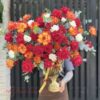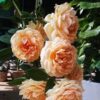### Pompadour Roses and Their Relationship with Wildlife

#### Introduction to Ecological Interactions
Pompadour Roses, with their lush blooms and intoxicating fragrance, serve not only as garden adornments but also as vital components of ecosystems, fostering intricate relationships with a diverse array of wildlife. From pollinators like bees and butterflies to birds and small mammals, Pompadour Roses play a crucial role in supporting biodiversity and promoting ecological balance. In this exploration, we delve into the fascinating world of Pompadour Roses and their interactions with wildlife, uncovering the symbiotic relationships and ecological significance that exist between these magnificent flowers and the creatures that inhabit their surroundings.
#### Pollinators: Partners in Reproduction
One of the most crucial relationships Pompadour Roses have in the wild is with their pollinators, including bees, butterflies, and other insects. As these pollinators visit the flowers in search of nectar and pollen, they inadvertently transfer pollen grains from one flower to another, facilitating the fertilization and reproduction of Pompadour Roses. In return for their services as pollinators, these insects benefit from the nourishment provided by the flowers, which fuels their flight and supports their life cycles. This mutualistic relationship ensures the continued survival and genetic diversity of both the roses and their pollinators, underscoring the interconnectedness of species in the natural world.
#### Birds: Beneficiaries of Seeds and Shelter
In addition to pollinators, Pompadour Roses also provide valuable resources for birds, including food, shelter, and nesting sites. After the flowers have been pollinated and the seeds have formed, birds may feed on the ripe fruits or seeds of the roses, helping to disperse them to new locations and promoting the spread of the plant species. The dense foliage and thorny stems of Pompadour Roses also offer protection and nesting sites for birds, providing a safe haven for raising young and sheltering from predators. In this way, Pompadour Roses contribute to the biodiversity of avian species and support healthy populations of birds in their native habitats.
#### Small Mammals: Foragers and Gardeners
Small mammals such as mice, rabbits, and squirrels may also interact with Pompadour Roses in various ways, ranging from foraging for fallen fruits and seeds to inadvertently aiding in seed dispersal through their activities. While some mammals may consume the fruits and seeds of the roses as part of their diet, others may inadvertently scatter seeds as they move through the landscape, contributing to the natural regeneration and spread of the plant species. Although these interactions may sometimes be perceived as challenges for gardeners, they are an integral part of the ecosystem and contribute to the ecological functioning of wild habitats where Pompadour Roses grow.
#### Conservation Implications
The relationships between Pompadour Roses and wildlife have important conservation implications, highlighting the role of these flowers in supporting biodiversity and maintaining healthy ecosystems. As human activities such as habitat destruction, pollution, and climate change threaten the survival of both roses and the wildlife that depend on them, conservation efforts become increasingly critical. By preserving natural habitats, reducing pesticide use, and promoting the planting of native species like Pompadour Roses, individuals can help create environments that support thriving populations of wildlife and ensure the continued survival of these magnificent flowers for generations to come.
#### Conclusion: A Tapestry of Life
In conclusion, Pompadour Roses are not only objects of beauty but also integral components of ecosystems, fostering relationships with a wide range of wildlife. From pollinators like bees and butterflies to birds and small mammals, the interactions between Pompadour Roses and wildlife create a rich tapestry of life that sustains biodiversity and promotes ecological resilience. By recognizing and appreciating these relationships, we can better understand the interconnectedness of species and work together to protect and preserve the natural world that sustains us all.
### Pompadour Roses and Their Relationship with Wildlife (Part 2)
#### Insects: A Symphony of Life
In addition to birds and mammals, Pompadour Roses also interact with a diverse array of insects, each playing a unique role in the ecological web:
1. **Bees**: Bees are perhaps the most well-known pollinators of Pompadour Roses. As they collect nectar and pollen from the flowers, bees inadvertently transfer pollen grains between flowers, facilitating fertilization and seed production. In return, Pompadour Roses provide bees with a vital food source and contribute to the pollination of other plants in the surrounding ecosystem, making them indispensable allies in the garden and beyond.
2. **Butterflies**: Butterflies are not only attracted to the vibrant colors and sweet fragrance of Pompadour Roses but also play a crucial role in their pollination. As butterflies flit from flower to flower in search of nectar, they inadvertently transfer pollen grains on their bodies, contributing to the reproductive success of the roses. Pompadour Roses, in turn, provide butterflies with essential nourishment and serve as valuable habitat for their caterpillars and larvae.
3. **Moths**: While moths may be less conspicuous than butterflies, they are no less important as pollinators of Pompadour Roses. Many species of moths are attracted to the fragrant blooms of the roses, which emit a sweet scent that becomes more pronounced at night. As moths visit the flowers to feed on nectar, they inadvertently pick up and transfer pollen grains, helping to ensure the continued reproduction of the roses and maintain genetic diversity within the population.
4. **Hoverflies**: Hoverflies, also known as flower flies, are frequent visitors to Pompadour Roses, drawn to the flowers by their bright colors and abundant nectar. While feeding on the nectar, hoverflies inadvertently transfer pollen grains between flowers, contributing to the pollination and reproduction of the roses. Additionally, hoverfly larvae are voracious predators of aphids and other garden pests, making them valuable allies in the fight against plant damage and disease.
#### Conservation Considerations
The relationships between Pompadour Roses and wildlife have important conservation implications, highlighting the interconnectedness of species and the need to protect and preserve biodiversity. As human activities such as habitat destruction, pollution, and climate change threaten the survival of both roses and the wildlife that depend on them, conservation efforts become increasingly critical. By creating pollinator-friendly habitats, reducing pesticide use, and promoting the planting of native species like Pompadour Roses, individuals can help create environments that support thriving populations of wildlife and ensure the continued survival of these magnificent flowers for generations to come.
#### Conclusion: A Harmonious Coexistence
In conclusion, the relationships between Pompadour Roses and wildlife are a testament to the intricate web of life that exists within ecosystems. From pollinators like bees and butterflies to birds, mammals, and insects, each species plays a unique role in the ecological functioning of the environment and contributes to the beauty and diversity of the natural world. By recognizing and appreciating these relationships, we can cultivate a deeper understanding of the interconnectedness of all living things and work together to protect and preserve the delicate balance of life on Earth. In doing so, we ensure a harmonious coexistence between Pompadour Roses and the wildlife that depend on them, creating a brighter and more sustainable future for generations to come.


